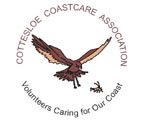Painstaking Preparations for our Precious Plants
For some years, Cottesloe Coastcare volunteers have developed their skills in collecting seeds from those remnant local coastal species that we saved, planted and nurtured at Grant Marine Park, Mudurup Rocks and the Vlamingh Memorial site.

The seeds are cleaned and further processed at APACE in Fremantle where volunteers also participate in specially conducted courses.
For our new project at the foredune opposite Bryan Way, we have some 2000 seedlings comprising 19 local species prepared for planting in June.
This image shows the foredune opposite as it was: highly degraded and full of introduced species.

 As you can see, Cottesloe Council workers worked with enthusiasm and we were able to use parts of the shrubs as brushing to avoid erosion. Some of the dead weeds will come in useful as mulch.
As you can see, Cottesloe Council workers worked with enthusiasm and we were able to use parts of the shrubs as brushing to avoid erosion. Some of the dead weeds will come in useful as mulch.
 Several weed species cannot be successfully removed by hand and some chemical weeding must be done. We contracted the expert services of David Taggart of Biara Conservation Services to do the herbicide work at the site, to help prepare the site for planting once the rains commence.
Several weed species cannot be successfully removed by hand and some chemical weeding must be done. We contracted the expert services of David Taggart of Biara Conservation Services to do the herbicide work at the site, to help prepare the site for planting once the rains commence.
Once the site was cleared of nature's introduced species, we had to clear it of human intrusions - we felt a bit like coolies, bagging house bricks and concrete debris that had been dumped at the site over the years as well as more recent throw-aways:
 After a couple of hours of lugging the bags full of stones, concrete and rubbish up the dunes, we had filled a whole trailer and the site looked neat and tidy, ready for planting.
After a couple of hours of lugging the bags full of stones, concrete and rubbish up the dunes, we had filled a whole trailer and the site looked neat and tidy, ready for planting.
Eventually, when our coastal natives thrive at this site, the habitat for our local dune residents will be so much more pleasurable!

